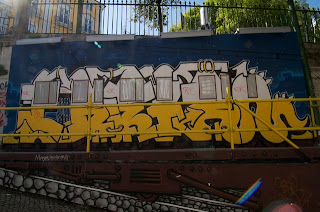Lisboa is no stranger to beautiful artistic presentations on walls and walkways - the decorative patterns, created with ceramic tiles called azulejos, are prevalent in public areas throughout this city - on buildings, in street signs and on walls, even, apparently, in the metro.
The front of this building is decorated with azulejos, a portion of which is shown in this photo. This building is located in a small open space (Largo) just off a main street and is home to a business that sells azulejos. It is about a 10 minute walk from our hotel, the Hotel Mundial.
This building is also just 10 minutes walk from our hotel. The entire front of the building is decorated in blue and white ceramic tile patterns with some cameo-like faces below windows as shown in the photo below.
This interesting rather ornate building has some colourful decorative tile displays above the windows at the top of the building as shown in the photo below.
There are two of these decorated areas each with slightly different depictions, on each side of this "wedge" shaped building.
We came across this building quite by accident when we were walking down from the Miradouro da Senhora do Monte look out - the highest point in Lisboa. (Some photos from the lookout will be included in a later post.) The building was on the edge of a small square by a market building behind the Igreja de Santa Egrácia - the National Pantheon. None of the buildings nearby had any decorative tile patterns on them - we have no information about this rather isolated and seemingly insignificant building and why it is so beautifully decorated.
On small walkways and large pedestrianized areas interesting patterns have been created with small gray and black stones that are set in place by craftsmen by hand. I am not aware of who decides on the patterns but attractive and interesting patterns there are, not only here in Lisboa, but elsewhere in Portugal, including the Algarve, the area we call home during our time here in Portugal.
The photo to the right shows a pattern on one of the main downtown streets, Rua Augusta, and the one below is the pattern on Rossio square which is just adjacent to Rua Augusta.
It may not be a surprise, then, that the city of Lisboa has taken a position on "graffiti" that is in contrast to the approach of many other large cities, especially those in North America.
Instead of trying to prevent this street activity and working, in vain, to clean it up, the city of Lisboa has apparently decided to embrace this form of art, not only by allowing it to survive but by allocating areas where street artists can create and display their work.
The result is interesting and the response, not surprisingly, mixed. While some of the displays are not particularly pleasing, many are visually very attractive, even beautiful, and most incorporate a message, not always easily interpreted.
We had read about the street art and had planned to look for some of them, but came across these displays by accident. We saw them in passing during our ride on the funicular Glória on the way up to the Miradouro de São Pedro Alcantara.
After our visit to the miradouro we walked down the street that we had come up on the funicular so we could get a closer look and take some photos. Similar Street Art appears in locations all over Lisboa.
Saturday, April 9, 2011
Subscribe to:
Post Comments (Atom)













No comments:
Post a Comment